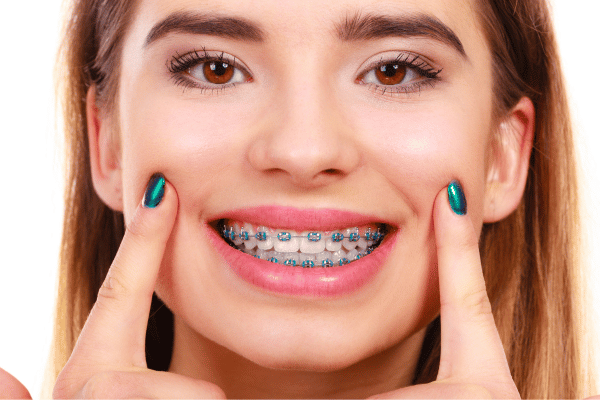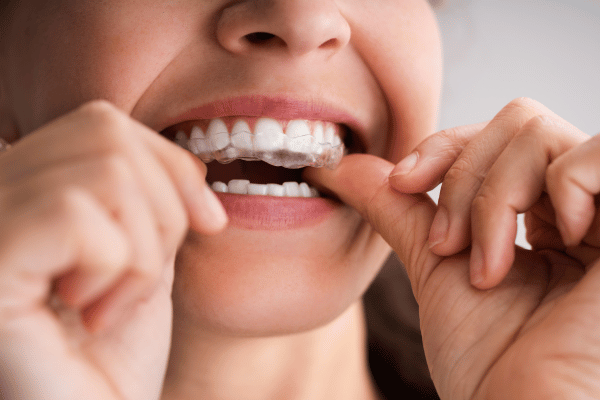
Detailed Comparison of Invisalign vs. Braces: Must-Read Guide
Choosing the right orthodontic treatment can significantly impact not only your smile but also your daily life during the treatment period. With advancements in dental technology, patients now have more options than ever, leading many to weigh Invisalign vs. braces. In this blog, we’ll help you make an informed decision on which option to choose between Invisalign or traditional braces. If you are on your own teeth straightening journey or if you’re considering Invisalign for kids or teens, this blog will discuss the pros and cons of both options.
Understanding Invisalign
Invisalign has revolutionized orthodontic treatment with its clear, removable aligners that offer a discreet way to straighten teeth. Unlike traditional braces, Invisalign aligners are made from a flexible thermoplastic material called SmartTrack, specifically engineered for the Invisalign treatment, providing comfort and precision. This system uses advanced 3D imaging technology to map out the complete treatment plan, from the initial position of your teeth to the final desired position. Each aligner is worn for about two weeks before moving on to the next in the series, gradually shifting your teeth into place. Invisalign is particularly effective for treating mild to moderate dental misalignments, including overcrowding, gaps, and certain bite issues.
Understanding Traditional Braces
Traditional braces have been the cornerstone of orthodontics for decades. They consist of metal brackets that are glued to each tooth and connected by wires and tiny rubber bands or elastics. Over time, braces have evolved, and today patients can choose from metal, ceramic, or lingual (behind-the-teeth) braces, making them more versatile and aesthetically pleasing than in the past. Traditional braces work by applying continuous pressure on the teeth to slowly move them into the correct alignment. They are known for their effectiveness in treating a wide range of orthodontic issues, including more severe cases that Invisalign might not address.
Key Differences Between Invisalign and Braces
When comparing Invisalign vs. braces, several key differences become apparent:
- Appearance: Invisalign’s clear aligners are virtually invisible, making them an attractive option for adults and teens who are self-conscious about the look of traditional braces. On the other hand, even though modern braces are less conspicuous than before, they are still more visible than Invisalign aligners.
- Comfort and Convenience: Invisalign aligners are removable, allowing for easier eating, brushing, and flossing. This removability also means there are no food restrictions, a significant advantage over traditional braces, which require avoiding certain hard or sticky foods. However, braces are fixed to the teeth, which can lead to discomfort from wire adjustments and the potential for food to get caught in the brackets.
- Treatment Duration: The Invisalign vs. braces results can vary greatly depending on the individual’s specific dental issues. In general, Invisalign treatment can be quicker for mild to moderate cases, with average treatment times ranging from 12 to 18 months, whereas braces might be required for 18 to 24 months or longer, especially for more complex adjustments.
- Cost: When considering Invisalign vs. braces cost, Invisalign can be more expensive than traditional metal braces, but the cost is comparable to that of ceramic or lingual braces. The final price for either treatment will depend on the complexity of the case, the duration of treatment, and geographic location.
- Effectiveness: Discussing Invisalign vs. braces effectiveness reveals that while Invisalign is highly effective for certain types of alignment and bite issues, traditional braces remain the best option for more complex orthodontic problems. Braces offer more control over tooth movement, making them suitable for severe crowding, malocclusions, and misalignments that Invisalign might not adequately correct.

Comparing Invisalign vs. Traditional Braces
| Appearance | Nearly invisible clear aligners | Visible metal or ceramic brackets |
| Comfort | Generally more comfortable with no wires | Can cause irritation due to wires |
| Removability | Removable for eating and cleaning | Fixed, cannot be removed |
| Treatment Duration | 12 to 18 months on average | 18 to 24 months on average |
| Cost | $4,000 – $6,000 | $3,000 – $8,000 |
| Effectiveness | Best for mild to moderate issues | Suitable for all types of orthodontic issues, including complex cases |
| Dietary Restrictions | No restrictions | Must avoid hard, sticky, and chewy foods |
| Maintenance | Easier to maintain oral hygiene | Requires meticulous cleaning |
| Discipline Required | Must be worn 22 hours a day | No compliance required, as they are non-removable |
Pros and Cons of Invisalign
Pros of Invisalign
- Aesthetic Appeal: The clear aligners are virtually invisible, making them an excellent choice for those concerned about the visibility of traditional braces.
- Removability: Aligners can be removed for eating, brushing, and flossing, offering a significant advantage in terms of oral hygiene and dietary freedom.
- Comfort: Without metal brackets or wires, Invisalign aligners offer a more comfortable fit and fewer instances of irritation.
Cons of Invisalign
- Discipline Required: Success with Invisalign requires wearing the aligners for the recommended 22 hours per day. Lack of discipline can lead to extended treatment times.
- Cost: Generally, Invisalign is more expensive than traditional metal braces, potentially making it less accessible to some patients.
- Limitations in Treatment: While effective for many cases, Invisalign may not be suitable for severe orthodontic issues, which traditional braces might address more effectively.
Pros of Traditional Braces
- Effectiveness: Braces are capable of treating a wide range of orthodontic issues, including complex cases that Invisalign might not address adequately.
- Cost-Effectiveness: Metal braces are often less expensive than Invisalign, providing a more budget-friendly option for extensive treatment.
- No Requirement for Discipline: Since braces are non-removable, treatment progress isn’t reliant on patient compliance.
Cons of Traditional Braces
- Aesthetic Concerns: The visibility of braces can be a significant drawback for adults and teens who are self-conscious about their appearance.
- Discomfort: The brackets and wires can cause irritation to the mouth, and adjustments may lead to temporary discomfort.
- Dietary Restrictions: Wearers must avoid certain hard or sticky foods to prevent damage to the braces.
Cost Comparison of Invisalign vs Traditional Braces

Here’s a detailed comparison between Invisalign vs braces cost, providing estimated costs to help guide your decision-making process. It’s important to note that these costs can vary widely depending on the complexity of the case, the duration of treatment, the geographic location, and the specific provider.
Invisalign Cost
Invisalign is often perceived as the more expensive option compared to traditional braces. The cost of Invisalign treatment ranges from $4,000 to $6,000 on average. Several factors can influence the final cost, including:
- Severity of dental issues being corrected.
- Duration of treatment required to achieve the desired results.
- Geographic location of the orthodontic practice.
- Additional costs for retainers post-treatment.
Note:
Insurance may cover a portion of the cost, and many orthodontists offer payment plans to make Invisalign more accessible.
Traditional Braces Cost
Traditional braces have a slightly broader cost range due to the variations in materials (metal, ceramic, lingual) and the complexity of the orthodontic issues they address. On average, the cost for traditional braces falls between $2,500 and $7,500. Key factors affecting the cost include:
- The type of braces chosen (metal are usually the least expensive, while lingual braces can be the most costly).
- Complexity and duration of the treatment plan.
- Geographic location, as costs can vary significantly from one region to another.
- Post-treatment retainers, which may add to the total cost.
Note:
Like Invisalign, insurance coverage and payment plans are generally available to help manage the cost of traditional braces.
Insurance and Payment Options
Both Invisalign and traditional braces are often partially covered by dental insurance plans that include orthodontic teeth straightening treatment. Coverage can vary, so it’s crucial to check with your insurance provider to understand the specifics of your policy. Additionally, many orthodontic practices offer flexible payment plans or financing options, allowing patients to spread the cost over the duration of the treatment.
Making the Right Choice for You
Deciding between Invisalign and traditional braces involves weighing several factors, including lifestyle, aesthetic preferences, the complexity of your dental issues, and budget. For individuals who value aesthetics and convenience, and have mild to moderate alignment issues, Invisalign could be the ideal solution. Conversely, those dealing with more severe orthodontic problems or looking for a more cost-effective treatment might find traditional braces to be better suited to their needs.
Consultation with an orthodontist is crucial to making an informed decision. An orthodontist can assess your specific situation and recommend the most effective treatment plan, taking into account your personal preferences and the technical requirements of your case.

Conclusion
The debate between Invisalign vs. braces depends on individual needs and preferences. Invisalign offers an aesthetic and convenient option for correcting mild to moderate dental issues, while traditional braces remain the gold standard for addressing more complex orthodontic conditions. Understanding the pros and cons of Invisalign and braces, as well as considering the cost, effectiveness, and results of each treatment, will help you make a choice that aligns with your lifestyle and dental health goals.
Ultimately, achieving a beautiful, healthy smile is the goal, and modern orthodontics provides several paths to reach that destination. Engage in a thorough discussion with your orthodontist to select the treatment that best suits your needs, ensuring a satisfying and successful orthodontic journey.
